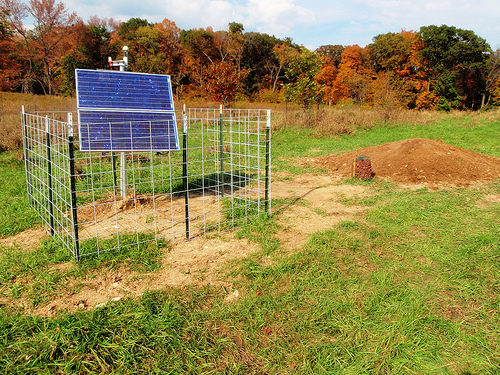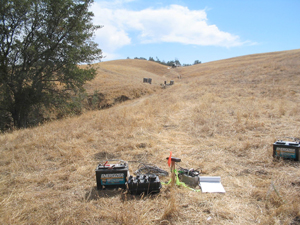L44A
Ryerson Woods, Lake Cnty Forest Preserve, IL, USA
The USArray component of the NSF-funded EarthScope project ended its observational period in September 2021 and all remaining close-out tasks concluded in March 2022. Hundreds of seismic stations were transferred to other operators and continue to collect scientific observations. This USArray.org website is now in an archival state and will no longer be updated. To learn more about this project and the science it continues to enable, please view publications here: http://usarray.org/researchers/pubs and citations of the Transportable Array network DOI 10.7914/SN/TA.
To further advance geophysics support for the geophysics community, UNAVCO and IRIS are merging. The merged organization will be called EarthScope Consortium. As our science becomes more convergent, there is benefit to examining how we can support research and education as a single organization to conduct and advance cutting-edge geophysics. See our Joining Forces website for more information. The site earthscope.org will soon host the new EarthScope Consortium website.




Principal Investigators and Institutions:
Yong-Gang Li ygli@email.usc.edu (Principal Investigator)John Vidale (Co-Principal Investigator)
Funding Source:
NSF EarthScope
Field Dates:
10/2004 – 1/2005
Equipment Used:
43 short period stations
Data Status:
Archive Complete
Release pending
Network Code:
YT
Description:
 EarthScope is a major earth science research initiative that will integrate scientific information derived from seismology (US Array), geodesy (Plate boundary Observatory), subsurface sampling and measurement (SAFOD), remote sensing (InSAR), and complementary geology and geophysics to understand continental scale plate deformation and evolution. Funding for the EarthScope initiative is currently being discussed in Congress as part of NSF's FY 2003 budget. The Division of Earth Sciences has made FY 2002 funds available for projects that qualify as pre-EarthScope activity, i.e. activities that will facilitate or enable the construction, fabrication, installation or operation of EarthScope once it is funded under the MREFC (Major Research Equipment Facilities and Construction) account. Such activities include meetings and workshops, prototype development, site selection or characterization.
EarthScope is a major earth science research initiative that will integrate scientific information derived from seismology (US Array), geodesy (Plate boundary Observatory), subsurface sampling and measurement (SAFOD), remote sensing (InSAR), and complementary geology and geophysics to understand continental scale plate deformation and evolution. Funding for the EarthScope initiative is currently being discussed in Congress as part of NSF's FY 2003 budget. The Division of Earth Sciences has made FY 2002 funds available for projects that qualify as pre-EarthScope activity, i.e. activities that will facilitate or enable the construction, fabrication, installation or operation of EarthScope once it is funded under the MREFC (Major Research Equipment Facilities and Construction) account. Such activities include meetings and workshops, prototype development, site selection or characterization.
This award will provide funds to support the deployment of dense linear seismic arrays across and along the San Andreas fault (SAF) near the SAFOD drilling site at Parkfield, CA to record fault-zone trapped waves generated by explosions and microearthquakes. Since the features of fault-zone trapped waves strongly depend on the fault geometry and physical properties, these waves can be used to determine spatial and temporal variation in fault properties with high precision. This experiment will be a supplement to other seismic experiments at Parkfield scheduled in the Fall of 2002.
In this research project, the PIs carry out field seismic experiments to acquire fault-zone guided waves (FZGW) generated by microearthquakes and explosions at the San Andreas Fault (SAF) Parkfield, California. Observation and preliminary modeling of 2-5 Hz trapped waves recorded at dense seismic arrays of 55 three-component seismometers deployed in 2002 on 500-1000-m long lines along and across the fault traces for events located within the fault zone shown evidence of a damaged core zone on the main SAF. The zone from the surface to at least 4-5 km depth is marked by a low-velocity waveguide ~150 m wide, in which Q is 10-50 and shear velocities are reduced by 30-40% from wall-rock velocities, with the greatest velocity reduction at shallow depth. This distinct low-velocity zone on the main SAF is interpreted as being a remanent of repeated damage due to M6 episode and historical large earthquakes on the principal fault plane at Parkfield. In the current FZGW experiment conducted closer to the SAFOD (San Andreas Fault Observatory at Depth) drilling site, more valuable data are recorded at along- and across-fault dense arrays for a bunch of shots detonated by USGS and refraction experiments, and microearthquakes occurring at various depths, including SAFOD "target" events at ~4km depths and deep events to the ~11km depths beneath arrays. The quantitative analysis and 3-D finite-difference modeling of fault-zone trapped wave data are to be carried out for a high-resolution delineation of the magnitude and extent of damage on the SAF nearby the drilling site, and draw the depth-dependent and lateral variations in internal structure and material properties of the fault zone. The body wave arrival times inversion for all shots will be used to obtain a quasi-3D local velocity structure for improvement of the numerical modeling of guided waves in terms of a refined structural model as a function of depth and distance along the fault. PIs plan to reoccupy seismic stations and repeat shots within the fault zone in 2004-2005. The data from the repeated experiment will be used to detect if there are the temporal changes in fault-zone material property before a pending M6 earthquake at Parkfield. The shear-wave splitting (SWS) analysis for earthquake data shall provide information on near-fault stresses. The 3-D finite-element dynamic rupture simulations based on the fault-zone structure delineated by trapped waves and the stress pattern from SWS will help better understand the relationship between the fault zone structure and dynamic rupture. Through data collection and analysis efforts in this project, PIs shall characterize the dimensions, magnitude and time dependence of the damaged zone on the SAF at Parkfield. The spatial extent of fault weakness compared to surrounding bedrock, and the loss and recouping of strength across the earthquake cycle are critical ingredients in understanding of fault mechanics and physics, as well as in estimation of losses from future earthquakes.
This research project is a supplement to the main program SAFOD among various components of EarthScope. The PIs are responsible on fault-zone trapped wave study while overall coordination between this supplementary project and scheduling of the field work for geophysical site characterization in SAFOD program will be done under the main project.
Publications/ Abstracts
Seismic Evidence for Rock Damage and Healing on the San Andreas Fault Associated with the 2004 M6 Parkfield Earthquake, Yong-gong Li, Po Chen , John E. Vidale, Elizabeth S. Cochran and Thomas Burdette, Bulletin of Seismological Society of America, September 2006, Vol. 96, No. 4, pp. S1-S15, doi: 10.1785/0120050803.
Seismic Velocity Variations on the San Andreas Fault at Depth Caused by the 2004 M6 Parkfield Earthquake and Their Implications, Yong-Gang Li, Po Chen, Elizabeth S. Cochran and John E. Vidale, 2007, Earth Planets Space, 59, 21-31.
Li, Y. (2007). Parkfield fault-zone guided waves: Low-velocity damage zone on the San Andreas fault at depth near SAFOD site at Parkfield by fault-zone trapped waves. Scientific Drilling/IODP. Vol. Sepetember, , Special Issue No. 1 (doi:10.2204/iodp.sd.s01.09.2007), pp. 73-77.
Li, Y. G. (2007). Low-velocity damage zone on the San Andreas fault at depth near SAFOD site at Parkfield by fault-zone trapped waves. Scientific Drilling. (Special Issue, No. 1), pp. 73-77.